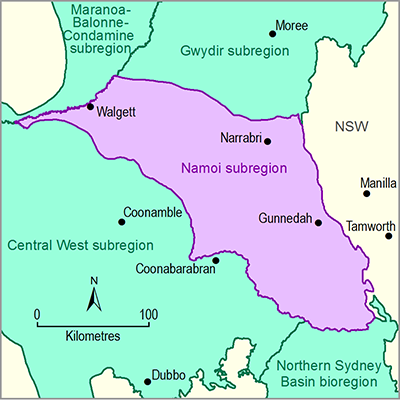A pertinent issue for the landscape classification component of the BA is formulating a topology that adequately reflects both the functional and structural complexity of the ecosystems, while delivering a succinct and consistent representation of the system that is ‘fit for purpose’. The systematic classification of the Namoi subregion undertaken here imposes discrete boundaries among landscape elements that may not adequately capture gradients within and across landscape classes. This approach tends to simplify important components of landscapes such as ‘transition’ zones or edges between landscape classes where key ecosystem processes and/or biodiversity are likely to peak. If landscape classes are treated purely as ‘closed’ ecosystems, the role of biotic interactions and energy exchange between adjacent systems may be poorly captured in our impact assessment. These conceptual challenges may not be readily overcome given the scope and scale of this assessment, but are important considerations for the subsequent stages of the risk analysis.
There are several technical issues that constitute important gaps in the landscape classification. Two different approaches to define GDEs were employed because the NSW Office of Water mapping (NSW Office of Water, Dataset 6) only included terrestrial vegetation and did not include riverine systems mapped within the stream network. Hence, the GDE Atlas (Bioregional Assessment Programme, Dataset 7) was used to classify the stream network as being potentially dependent on groundwater. The other obvious gap is that all GDE mapping and classification approaches lack systematic ground-truthing. This is especially true in areas with extensive intact native remnants, such as the Pilliga Forest, where large areas of ‘Grass woodland GDE’ landscape class were identified but the lack of published studies on vegetation – groundwater interactions limits the Assessment team’s ability to define the nature of this interaction.
Close inspection of the ANAE wetland mapping (ABARES, Dataset 2) and the NSW regional native vegetation mapping (NSW OEH, Dataset 3) revealed some mismatches, therefore data were combined where appropriate.

Product Finalisation date
- 2.3.1 Methods
- 2.3.2 Summary of key system components, processes and interactions
- 2.3.3 Ecosystems
- 2.3.4 Coal resource development pathway
- 2.3.5 Conceptual modelling of causal pathways
- Citation
- Acknowledgements
- Currency of scientific results
- Contributors to the Technical Programme
- About this technical product
